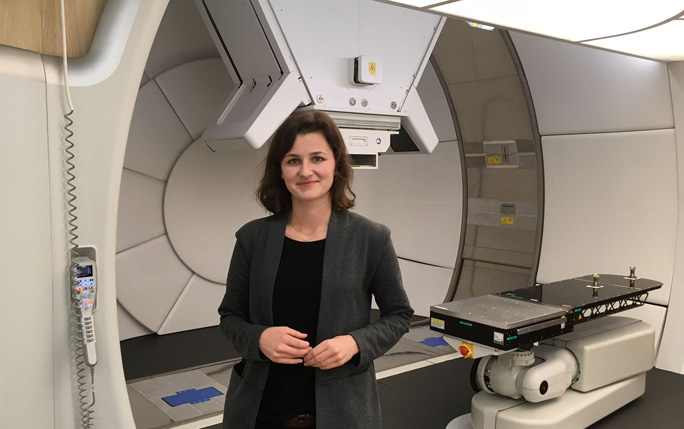Geometry of an energy degrader in a cyclotron-based proton therapy facility

In a cyclotron-based proton therapy facility, the fixed extraction energy of protons is reduced downstream of the accelerator source to the energy range required by the treatment plan. Most typically, an energy degrader made of a robust material, i.e., graphite, of variable thickness is inserted into the beamline. The beam passing through the absorber material undergoes the ionisation slowing, but also acquires a larger emittance due to the multiple Coulomb scattering. The degrader is hence followed by a set of collimators to select an appropriately small portion of the beam to be transported to the patient. Such a system introduces beam losses that significantly vary depending on the exit energy; at 70 MeV the transmission from the cyclotron to the isocentre can be as low as 0.1%.
A team including OMA Fellow Ewa Oponowicz examined three different geometries of a graphite degrader: multiple wedges, multiple slabs and a single block, of equivalent total thickness, to determine which arrangement minimises the beam losses. Measurements of the PROSCAN beamline with the conventional multi-wedge degrader at the Proton Therapy Centre at Paul Scherrer Institute (Switzerland) were used to validate the Monte Carlo simulations. Careful calculations of the emittance at the degrader exit were necessary to reliably compare the three cases.
Ewa said: “These were very fruitful studies; they mainly focused on various geometries of the energy degrader, but also prompted considerations on careful emittance calculations and motivated a new experimental method to determine the material ionisation potential.”
The researchers determined that a solid block case delivers significantly larger particle transmission for the entire range of treatment energies, and up to 17% larger at 150 MeV. They therefore concluded that a single block degrader is the geometry that should be considered in cyclotron-based proton therapy systems to improve the overall beam transmission. Further studies into optimisation of the degrader performance are ongoing and focus on novel materials, such as boron carbide B4C.
Further information
Oponowicz, E., H. L. Owen, S. Psoroulas, and D. Meer. "Geometry optimisation of graphite energy degrader for proton therapy." Physica Medica 76 (2020): 227-235. DOI: 10.1016/j.ejmp.2020.06.023